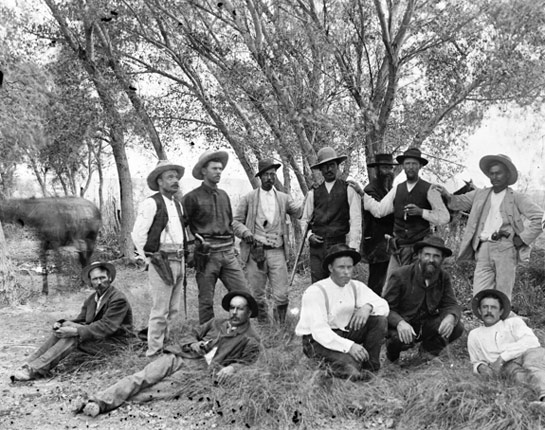The latter half of the 19th century saw the "golden age" of the American cowboy; newly-built railroad lines made it easier to transport cattle from the western plains to the east coast, where they could fetch top dollar. As these photos reveal, a cowboy's life was a hard one, but living freely on America's western frontier nevertheless appealed to thousands of men.
These photos were taken across the American West between the late 1800s and the early 1900s.
-

In 1867, the first railroad line opened from Abilene, TX to Chicago, beginning the "golden age" for the American cowboy. It would last until the winter of 1885-86, when the cold weather would kill off 85% of the cattle in Texas/American cattle/whatever. (This photo was taken between 1875-80).
Credit: Art Archive -

Most of the first Anglo cowboys originated as Confederate veterans of the Civil War and immigrants from the North who left their homes in search for jobs. Like Billy the Kid, these cowboys headed West in order to find better lives. (c. 1900)
Credit: Art Archive -

The cowboy's dailylife was dangerous. Being dragged by a horse was the most common cause of death, but cowboys also died from stampedes, lightning strikes and exposure. (late 1800s)
Credit: Art Archive -

Unable to work as a cowboy due to his slender physique, Billy the Kid’s first job on the range was as a cook at the chuck wagon. Some of his jobs included cooking meals, washing dishes, making bread, caring for the horses, and building a fire. Although the working hours would have been long, usually beginning well before dawn and ending after sunset, the cook was typically highly respected by the cowboys he fed. (1905)
Credit: Corbis -

While now a defining symbol of the American cowboy, the cowboy hat served multiple functions. The wide-brim protected the wearer's eyes from the sun, the high-crown provided a cup with which to scoop water, and when folded over, the hat served as a pillow. (Denver, 1904)
-

Many cowboys were not Anglo, but African-American, Mexican, and Native American. However, only the white cowboys have been included in western folklore. The Mexican vaqueros lived in the New Mexico Territory well before American settlers. (Navajo men race bareback, Denver, CO)
Credit: Denver Public Library -

Although they were harmless on the plains, cowboys were often dreaded in towns, where they had a reputation for drunkenness. Many residents believed cowboys, as a class, to be morally corrupted, vulgar, profane, and lecherous. Several towns created gun control ordinances that fined and imprisoned those who insisted on wearing a six-shooter. (Lincoln County Warriors)
Credit: Haley History Center -

Saloons, frequently outnumbering other establishments two to one, attracted cowboys from miles around. Inevitably, they also became centers of frontier violence. Billy the Kid's first murder occurred in a saloon similar to this one. (Peco, TX, 1880s)
Credit: Haley History Center -

Twice a year, ranchers would hold a roundup. In the spring, cowboys would collect the livestock in order to brand the young cattle. In the fall, the cattle would be collected again, selected for market, and transported to the nearest rail line. (Belle Fourche, SD, 1887)
Credit: Library of Congress -

Chicago, IL was the end of the line for much of the livestock, which would be slaughtered and packaged for sale back East. The profits for Western ranchers became so lucrative that in fewer than two decades, cowboys moved six million steers and cows to railroad outposts. (Chicago stockyards, 1895-1905)
Credit: Corbis -

<In the="" winter="" season,="" owners="" maintained="" their="" cattle="" with="" a="" small="" staff.="" Consequently,="" many="" cowboys="" lost="" their="" jobs="" during="" the="" colder="" months="" of="" the="" year.="" In="" order="" to="" support="" themselves="" financially,="" cowboys="" often="" took="" on="" odd="" jobs="" at="" saloons="" and="" stables="" or="" found="" work="" by="" mining,="" hunting,="" or="" trapping.<="" span="">
Credit: Arizona Historical Society -

Wolves provided a nuisance to ranchers so cowboys were often sought to kill the threat to their livestock. A captured wolf like this one was extremely rare and valuable. (Wyoming, 1887)
Credit: Library of Congress









